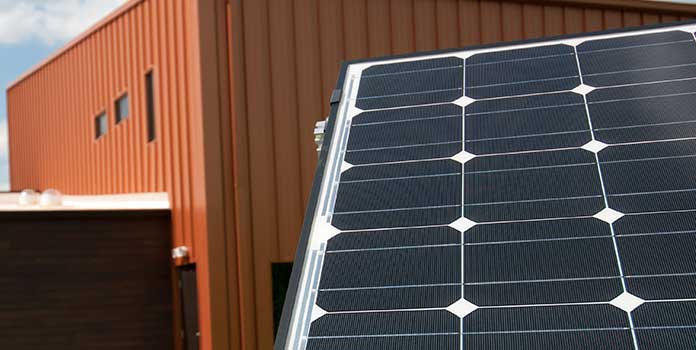Best Solar Panel Kits
The best solar panel kits for 2019 mix cost, ease of installation, and quality.
Installing your own solar installation can be a gratifying experience, but finding and buying all the components for your own situation can be a pain. Solar kits greatly simplify the design and installation process. Instead of piecing together your entire kit, just figure out the size you need and have it shipped to your home. Though you might have to buy a few extra pieces, most kits include the basic items to get you up and running off the sun!
Here, we review several of our top picks for best solar panel kits for 2019. We look at small, medium, and large kits for both off-grid and grid-connected use.
If you want to learn a bit more about how solar kits works and what to consider before purchasing a kit, read on until the end.
Best Solar Panel Kits for 2019
Below, we look at the best small, medium, and large solar kits, diving into equipment, pros and cons, and what makes each kit special. Here’s a quick peak at our list before we dive in, starting with the smallest:
- Best All-In-One Kit: WindyNation 400 Watt Solar Panel Kit
- Best Basic Kit: Renogy 400 Watt 12 Volt Monocrystalline Solar Starter Kit
- Best For Adding Panels: Grape Solar 400-Watt Off-Grid Solar Panel Kit
- Most Efficient Kit: HQST 400 Watt 12 Volt Monocrystalline Solar Panel Kit
- Best Overall Kit: Renogy 1800 Watt Kit
- Easiest-to-Install Kit: PluggedSolar 1.5kW Grid-Tie Kit
- Best Deal: PluggedSolar 5kW Grid-Tie Kit
- Most Efficient Kit: Grape Solar 5300 Watt with Enphase Microinverters
As you can see, no matter what size you’re looking for, there’s a kit for you. From small 400 watt systems designed for smaller RVs to giant 5,000 watt kits that can power an entire home, you’ll find exactly what you need.
Let’s take a look at each of these kits more in depth. For easier reading, we’re going to break down this list into three sections: small kits around 400 watts, medium kits around 1500 watts, and large kits above 5000 watts. If you want some advice on choosing a solar kit, scroll down to the sections at the bottom first!
Best Small Solar Kits (400 watts)
At 400 watts, these kits are designed mostly for small RVs, campers, or very small off-grid systems like a shed or tiny house. All these kits are designed for off-grid use, so if you’re home is connected to the grid, you’ll need to look elsewhere (though we’ve got some options for you below!)
The exact components each kit includes varies and you’ll likely have to purchase a few extra pieces separately. However, each kit includes the basic items you’ll need – solar panel, charge controller, wiring, and mounting hardware – and is designed to work in conjunction with a battery.
Expect small systems to be fairly cheap, easy to install, and able to cover 100% of your energy needs if you’ve got light usage. A 400 watt solar panel in Austin, Texas, for example, can produce about 1500 watt-hours of electricity a day. That’s more than enough energy to power a few LEDs for several hours, charge a couple laptops, run a water pump for a kitchen sink, and a few other odds-and-ends.
Best All-In-One Kit: WindyNation 400 Watt Solar Panel Kit
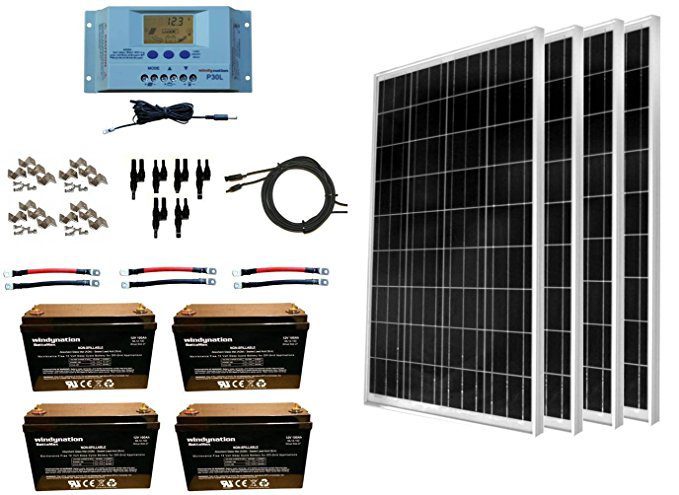
Let’s start off with a bang! If you’re looking for a kit that has almost everything you need, the WindyNation 400 Watt Kit has got you covered – all for a fairly reasonable cost. Unlike most kits that only come with the panels, charge controller, and wiring, this kit includes all that as well as the inverter and batteries! It includes:
- 4 100-watt polycrystalline solar panels
- 1500 watt modified sine wave inverter
- 30 amp PWM charge controller with battery temperature sensor
- 4 100 amp-hour AGM batteries (for a total capacity of 400 amp-hours)
- wiring (panels to charge controller, battery to inverter)
- mounting hardware
The AGM batteries are a great option for RVs or systems where you’ll store the batteries indoors. They are completely sealed, so they won’t spill, don’t produce any dangerous gases, and don’t require any maintenance. A great option for anyone really, though they’re much heavier than lithium-ion batteries and won’t last as long (though they’re much cheaper too).
The only thing this kit doesn’t include is fuses, as many customers noted in their reviews, so you’ll have to buy some if you purchase this kit.
Overall, customers love the ease of installation and note the kit seems well-made. Many buyers are adding it to their RV and find it can cover all their electricity needs. One even noted they use it for their work trailer on construction sites to power up tools and rechargeable batteries.
However, this kit includes a modified sine wave inverter, which some power tools can’t handle, so if you’re looking to use this kit for your own energy needs on the construction site, check your tools beforehand. If they can’t handle a modified sine wave, you’ll need to opt for a kit with a more-expensive pure sine wave inverter (like Grape Solar’s kit below).
Thanks to the impressive value it provides, the 400 watt solar kit by WindyNation is our top pick for the best small solar panel kit. It’s not the cheapest kit, but provides the best bang for your buck.
Pros:
- WindyNation customer service is helpful and responsive.
- Plenty of power for light usage, and will happily support appliances such as microwaves, hair dryers, and blenders (though with a 1500 watt inverter, these energy hogs are on the high end of what this kit can handle).
Cons:
- As mentioned, you’ll need to purchase fuses and wiring to connect the charge controller to the battery, as they aren’t supplied with the kit. Sourcing these parts is easy and the fuse and fuse holder are typically not too expensive for a small system like this.
- The inverter is a modified-sine model, which may not play well with sensitive electronic devices like some power tool batteries, computers, and CPAP machines.
Best Basic Kit: Renogy 400 Watt 12 Volt Monocrystalline Solar Starter Kit with Wanderer
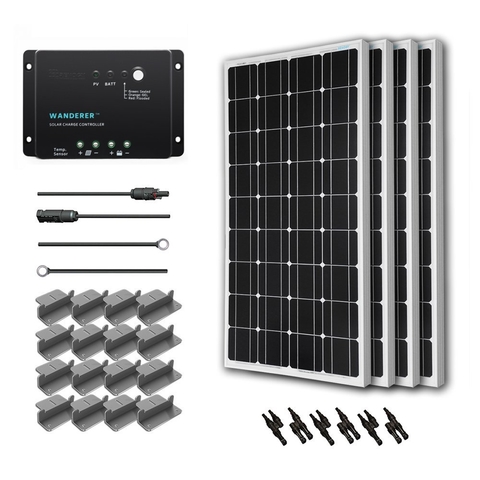

Renogy is one of the leading manufacturers of equipment for small-scale solar installations. They produce everything from solar panels to mounting hardware to batteries. Their 400 Watt Solar Starter Kit is a less expensive, more bare-bones option than many others out there and it’s the perfect solution if you’re looking for a simple kit. It includes:
- 4 100-watt monocrystalline silicon solar panels
- 30 amp Wanderer PWM solar charge controller
- wiring (panel to charge controller, charge controller to battery)
- 6 branch connectors (for wiring solar panels in parallel. It’s those two-into-one adapters in the picture above)
- mounting hardware
It comes with the solar panels and charge controller, the mounting hardware, and wiring. Keep in mind though that there’s no inverter or batteries, so while you will save on the initial purchase, you’ll still need to buy this equipment as well as fuses, wiring to connect the charge controller to the battery and battery to inverter, as well as the battery itself.
Renogy keeps cost down by including a more cost-conscious PWM charge controller – as opposed to a more expensive MPPT controller – but if you’re looking to pair your solar kit with a lithium-ion battery, you’ll have to keep looking, as lithium batteries aren’t compatible with most PWM controllers.
That said, this is a great solar panel kit in terms of customer reviews and quality. If you already have some parts or want to buy a specific lead-acid battery or an inverter that isn’t included in any kit, Renogy’s kit is exactly what you need.
Pros:
- Renogy’s website has a lot of information to assist you in assembling the kit. More info is always handy when installing your first solar system!
- Renogy is a well-known manufacturer of solar equipment for small installations. Equipment is high-quality.
Cons:
- To make use of this kit you’ll still need to purchase deep cycle batteries, an inverter, and fuses.
Best For Adding Panels: Grape Solar 400-Watt Off-Grid Solar Panel Kit
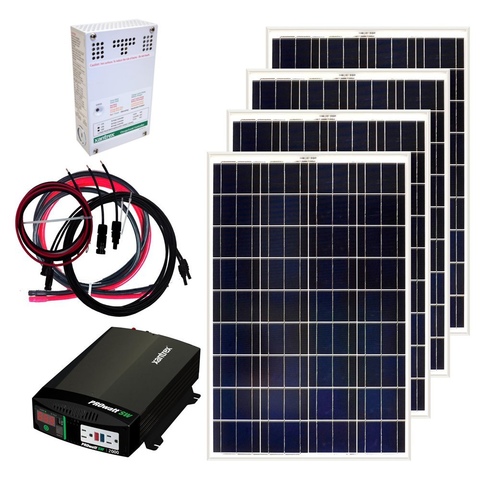

The Grape Solar GS-400 kit is a nice package for consumers that are searching for a simple and basic – but high quality – solar set up.
Unlike the more basic kits, Grape’s kit comes with a large pure sine wave inverter that can handle bigger appliances and/or more appliances at the same time. And because its a pure sine wave inverter, you’ll have no problem with sensitive electronics like CPAP machines and laptops.
This kit also includes a 35 amp charge controller – larger than most – and Grape Solar says you can safely add one more 100 watt panel to the kit, bumping up your potential solar capacity to 500 watts.
In total, the kit includes:
- 4 100-watt polycrystalline panels
- 35 amp PWM charge controller
- 1800 watt pure sine inverter
- wiring (everything you need!)
On top of that, both the inverter and the charge controller are manufactured by Xantrex, a subsidiary of Schneider Electric, one of the biggest names in the solar equipment industry, so you can rest assured that you’re getting exceptional quality.
With the simplicity of the kit, it should be very easy to setup even for the novice solar installer, though you’ll have to buy your mounting hardware separately.
Pros:
- Easy installation, with well written guides for everything you need to do.
- Larger inverter and charge controller, so you can add an additional solar panel.
- Charge controller and inverter from an industry-leading manufacturer
- Grape Solar give a fantastic standard of customer service – you can call them with any question or problem and they will go out of their way to help.
Cons:
- Batteries aren’t included, so you will need to purchase at least one 12 volt deep cycle battery in order for the kit to work.
- Mounting hardware also isn’t included, so you’ll need to source the racks and the assorted nuts and bolts from somewhere else.
Most Efficient Kit: HQST 400 Watt 12 Volt Monocrystalline Solar Panel Kit
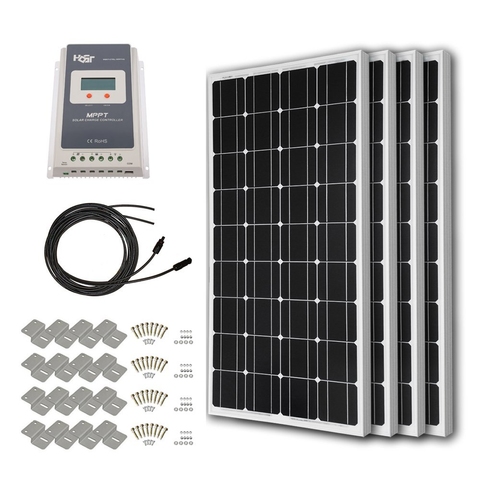

Last, but not least, is another affordable bare-bones kit that was built specifically for people new to solar. Similar to the other kits above, HQST’s kit includes the panels and charge controller, with basic wiring and mounting equipment:
- 4 400-watt monocrystalline solar panels
- 40 amp MPPT solar charge controller
- wiring (panels to controller)
- mounting hardware
However, this kit stands out for the high-quality components included.
First off, you get premium monocrystalline solar panels, as opposed to the more common polycrystalline panels that come with many kits. Mono panels are generally more efficient than poly panels, so should get a bit more electricity from the same physical dimensions.
Secondly, this is the only kit that includes a 40 amp MPPT (Maximum Power Point Tracking) charge controller. MPPT controllers are more expensive than the PWM controllers included in all the kits above, but benefit from greater energy production in poor weather, especially when paired with larger systems.
Also, if you’re looking to install lithium-ion batteries with your solar kit, HQST’s offering could be a good start, since lithium-ion batteries aren’t compatible with cheaper PWM controllers. Every year, lithium-ion batteries become more affordable and with their ultra-long lifespan, many models are already as cost-effective as the ubiquitous lead-acid battery – though they take a long time to recoup that high purchase price.
And as the controller can handle 40 amps, you can safely add another 100 watt panel, bumping up your total solar capacity to 500 watts. And you get all this for around the same price as the kits above!
While this kit doesn’t enjoy the sheer number of reviews like some of the others have, customers absolutely love the high-quality components it includes. One reviewer who installed the kit on his cabin, particularly praised the MPPT controller for its excellent energy production compared to his previous PWM controller, saying his panels can now continually power his entire home.
Pros:
- The MPPT charge controller is more efficient than the PWM controllers offered in the other kits.
- Kit includes monocrystalline panels.
- Can add an additional panel or two to the system without upgrading the charge controller.
Cons:
- Like the other bare-bones kits, you will need to supply a lot of other components – like wiring, fuses, inverter, and battery – yourself before you have a working system.
Best Medium Solar Kits (1,500 watts)
If you’ve got a medium-sized off-grid cabin or small home, the kits above just aren’t going to cut it for you. They’re too small and likely won’t produce all the electricity you need to keep your home working properly. If this is the case, it might be time to bump up to the next size kit.
At 1,500 watts or more, you’ll see solar kits designed for off-grid systems as well as kits for grid-connected homes. Mostly designed for off-grid cabins, they’re simply physically too big for an RV or camper.
Below, we’ve chosen a couple of our favorite medium-sized solar kits, one for grid-connected homes and one for off-grid systems. As you go larger in size, your available options begins to dwindle. Small solar kits are much more popular than medium/large ones! But don’t get too sad, you’ve still got options.
A 1,500 watt solar installation will produce varying amounts of electricity, depending on the location. After all, hot Arizona is very different than Washington or Vermont. In Virginia, for example, you can expect a well-designed 1,500 watt installation to produce about 170 kWh per month (equal to 5,500 watts-hours per day) on average.
At this size, you’re able to power your fridge, fans, lights, clothes washer and dishwasher – though energy-hogging air conditioners are still very much off-limits.
Best Overall Kit: Renogy 1800 Watt Kit
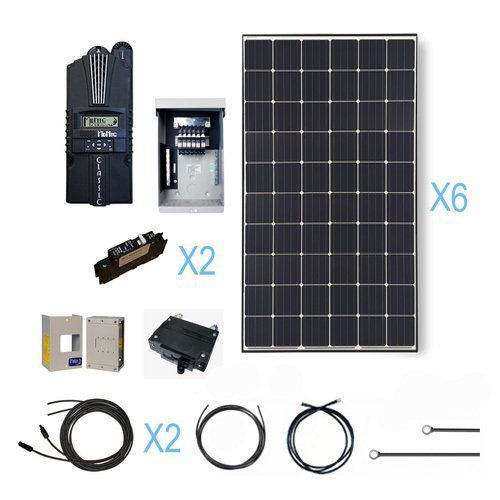

Renogy’s 1800 watt kit is designed for medium-sized off-grid systems. With six 300-watt panels, you’re able to power TVs, kitchen appliances, washing machines, and even refrigerators. Renogy is well-known in the solar industry for manufacturing components for small- to medium-sized off-grid systems, and you’re in good hands with this kit.
They’ve put together a quality kit here, pairing their own panels with equipment from Midnite Solar, a trusted company that makes some of the best charge controllers currently on the solar market. In full, the kit includes:
- 6 Renogy 300-watt monocrystaline panels
- 96 amp Midnite Solar Classic MPPT charge controller
- combiner box
- 3 circuit breakers
- quad enclosure (to house circuit breakers)
- wiring
The included 96 amp Midnite Solar Classic MPPT charge controller is able to eke out more energy from the panels, especially during extreme hot or cold weather and on cloudy days. And with the included app, you can monitor your system’s production straight from your computer with no additional equipment or costs.
MPPT controllers are also compatible with lithium-ion batteries, so if you’re looking to spend extra cash on these long-lasting batteries, this Renogy kit might be a good fit, though read up online about others’ experience combing the Midnite Classic with lithium batteries before moving forward.
This kit comes in a variety of sizes, from a small of 1,200 watts all the way up to 3,600 watts. All kits include monocrystalline solar panels and similar Midnite Solar components. While this kit comes with all the wiring, disconnects, and boxes you need, you’ll have to buy your own mounting hardware, inverter, and battery bank, as they’re not included.
Few reviews are available, but one reviewer noted they’ve been using this kit without incident for a full year. That coupled with Renogy’s great reputation and size leave us comfortable recommending this kit.
Pros:
- Kit includes quality Midnite Solar charge controller and enclosures.
- Includes components other kits don’t, like the combiner box, circuit breakers, and breaker enclosure, as well as all the wiring.
- Fair price for the quality and ease of purchase – just get a battery and inverter and you’re good to go!
Cons:
- No mounting hardware, inverter, or batteries, so you’ll have to buy them yourself.
- Other than that, none at all. It’s a sweet system!
Easiest-to-Install Kit: PluggedSolar 1.5kW Grid-Tie Kit
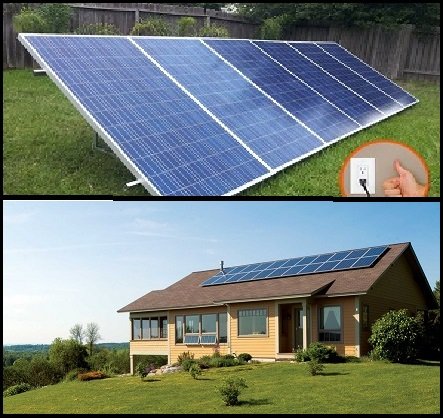

PluggedSolar produces plug-and-play solar kits for grid-tied homes. Their kits are fundamentally different than pretty much any other solar kit out there – or any other solar installation period, for that matter.
Traditional grid-tied solar installations are almost always permanently hard-wired to a home’s electrical panel (the electrical box on the side of the house). Electricians come to your home and run the solar panel wires from the roof and down your exterior wall – all in protective metal conduit – and into into the electrical panel via an electrical breaker.
PluggedSolar kits though are much more simple. You simply connect the solar panels to each other and plug them into an outlet in your home.
Compared to most residential solar, these kits are a snap to install. Just install the panels on the roof and literally pop the cord into a 120v or 240v outlet. PluggedSolar notes that it needs to be a dedicated outlet that only the solar installation uses, otherwise you could overload the wiring.
The kit comes with a microinverter for each solar panel, so you don’t need a large inverter on the side of your home either. And since you don’t have to connect directly into your home’s electrical panel and there’s no additional safety disconnects, string inverter, or combiner boxes to install, you save huge amounts of time and money.
The kit includes:
- 6 240-watt polycrystalline solar panels
- 6 microinverters
- plug-in wireless monitor
- wiring (from panels to outlet, which is all you need)
You’ll notice that PluggedSolar doesn’t include any mounting hardware – just the panels and inverters – so you’ll have to purchase that separately. The company sells mounting kits for both ground- and roof-mounted systems, so it should be fairly easy to find the right equipment.
You might be ready to jump on the plug-and-play bandwagon, but hold your horses. Plug-and-play solar comes with a lot of baggage, as some/most utilities won’t touch it with a 15 foot pole due to safety considerations. As such, you need to contact your utility before buying any kit to make sure they even allow this type of installation and whether or not they’ll allow you to install it yourself. Our advice: don’t get your hopes up too high.
Still, we include PluggedSolar’s kit here because, well, it’s cool and they’re certainly at the front of the pack in regards to plug-and-play solar. And if your utility allows it, it’s a pretty sweet option.
Pros:
- Easy and quick to install, just plug it in!
- No need to hire an electrician to install equipment/wiring (depending on your home).
- 10 year warranty on the microinverters.
Cons:
- Possibly not allowed in your area, depending on the utility.
- Kit does not include mounting hardware, you’ll need to purchase separately.
- Need a dedicated circuit in your home. If one is not available, you’ll need to hire an electrician to install one.
- PluggedSolar does not publicize the solar panel manufacturer, so no information on panel warranty, quality, or efficiency is available.
Best Large Solar Kits (5,000 watts)
Need a big system for your home? Those little kits above just too dinky for your needs? Then let’s take a look at the behemoths! The average residential grid-tied solar installation in the US is 5,700 watts, so you’re getting into full-sized solar here. At this size, you can power all the appliances you need – even your energy-hogging air conditioner (depending on size).
A 5,000 watt solar system in Denver, Colorado, produces an average of 670 kWh each month. For a small one- or two-bedroom home, that’s enough to cover all your energy needs, including AC, as long as you use it responsibly.
With kits this size, you’ve got to really plan the system out, as they usually include 15 to 20 panels. Do you have enough roof space? Is your neighbor’s tree shading too much of your roof? How are you going to run all the wiring? All these questions, and more, need to be worked out before you even begin to install your system.
Still, getting on your roof and installing your own large solar kit is possible and many people have done it before you!
Below you’ll find our top 2 picks for large solar kits. Both are grid-tied systems using microinverters, but each has it’s own benefits.
Best Deal: PluggedSolar 5kW Grid-Tie Kit
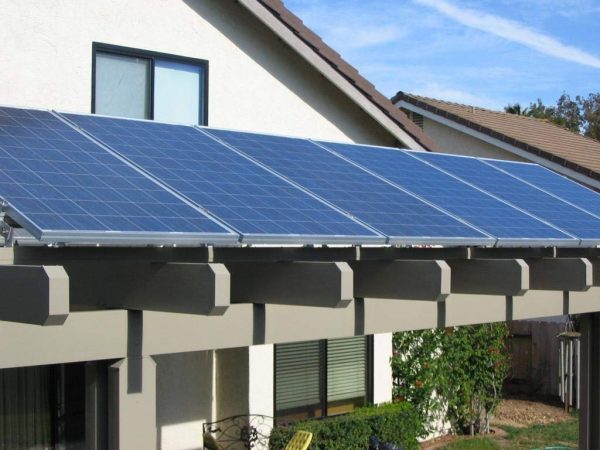

PluggedSolar kicks off our list of the best large solar kits. We looked at their smaller plug-and-play option above, but now we’re looking at their more traditional 5kW grid-tie kit that is designed as a typical solar installation, not to be plugged into an outlet.
The kit includes microinverters to optimize panels individually. Unlike the Grape kit below, PluggedSolar doesn’t include Enphase products, and they only include 8 microinverters for 16 solar panels, so 2 panels will have to share a single inverter. With this system, each panel isn’t optimized individually, but in pairs, and this can affect your production more if there’s any shading issues. Still, it’s better than a conventional string inverter that treats all the panels as one giant panel.
All told, the kit includes:
- 16 315-watt polycrystalline panels
- 8 microinverters
- Unirac mounting hardware
- production monitor
- wiring (to connect inverters/panels to electrical panel)
- AC disconnects (a safety requirement of most, if not all, utilities)
You’ll see that this kit includes all the mounting hardware you need, from well-known racking manufacturer Unirac. That’s a huge bonus, as they’ve already picked out the exact equipment for your install. You just need to figure out how to safely install it on your roof, then get it done!
Of course, just like any grid-tied kit, you’ll probably still have to hire an electrician to connect your solar installation to your electrical panel, as most jurisdictions only allow professional electricians to mess with anything in your electrical panel, but that’s not a huge task and only takes a few hours.
Considering the equipment included, this kit offers pretty good bang for the buck, coming in at much less than other similarly-sized products.
Pros:
- Good value compared to other large solar kits out there.
- About as all-inclusive as you can get. Just like any kit, you’ll still need to buy electrical conduit and accompanying components, but that’s stuff you get at Home Depot, not from your solar manufacturer.
Cons:
- Kit only provides a single microinverter for every 2 panels. While it certainly works, this set-up means your solar panels aren’t optimized individually, but in pairs. While you’ll still see better energy production than with a standard string inverter (which optimizes the entire solar installation as a single unit), it’s not quite as good as a having a dedicated microinverter for each panel, as is common in the industry.
- PluggedSolar doesn’t specify panel manufacturer, so we can’t check panel quality, warranty, and reputation. You’d want to ensure it’s a quality product before purchasing!
- Just like any grid-tied kit, you’ll still need to hire an electrician to connect the components on the roof to the electrical panel as well as any safety disconnects your jurisdiction requires.
Most Efficient Kit: Grape Solar 5300 Watt with Enphase Microinverters
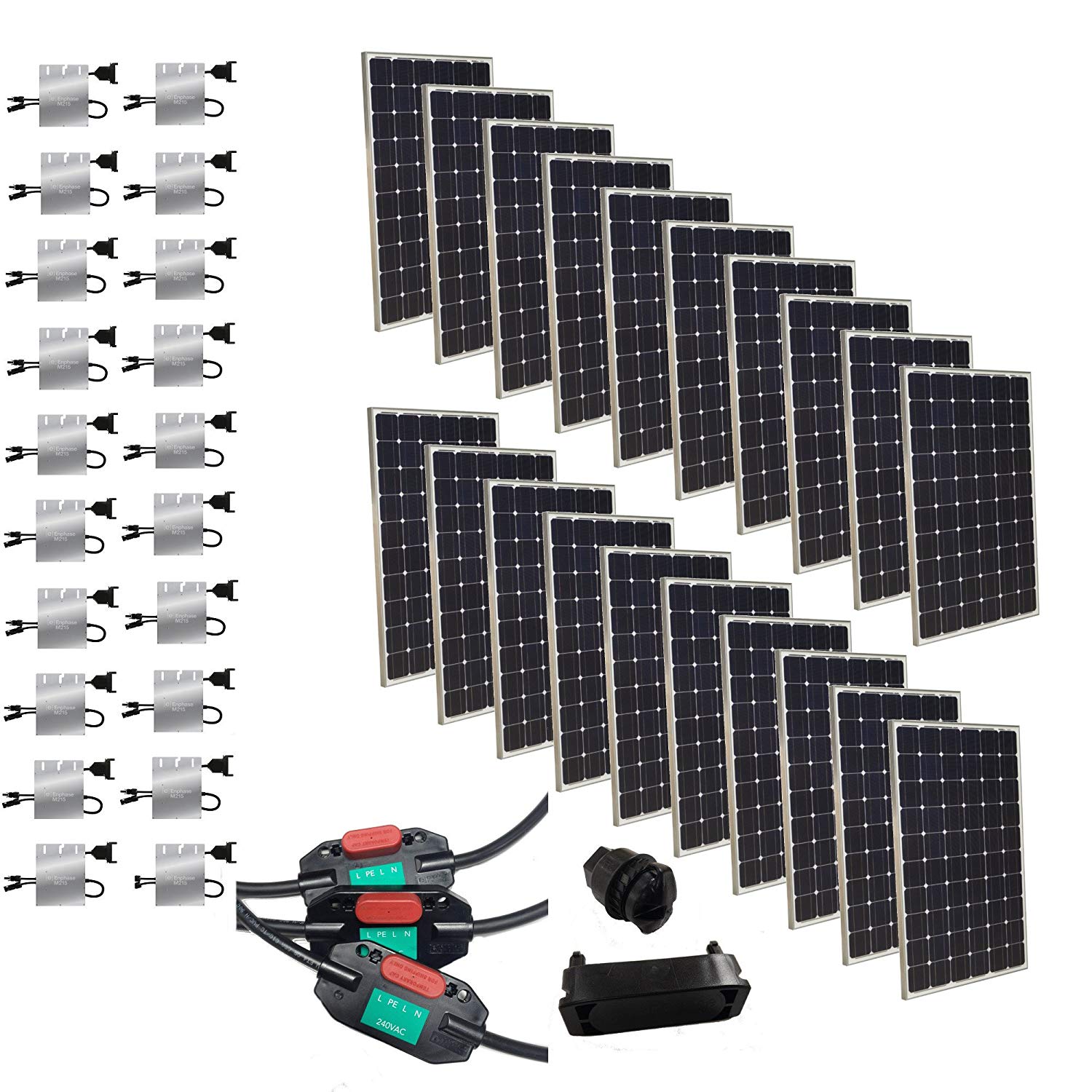

We already looked at Grape Solar’s 400 watt kit above and now we’re jumping to one of their largest offerings, their 5300 watt solar kit with Enphase microinverters.
While this kit only comes with the panels, inverters, and special wiring to connect the inverters, the components are top-notch. Enphase is the hands-down leader in microinverters and thousands upon thousands are installed across the US. They’re extremely efficient, optimize each panel individually for max production, and create a sleek-looking installation, as you don’t have a hefty inverter installed on the side of your home.
Because Enphase microinverters are connected directly to the solar panel, they are designed for grid-tied homes, so consider this kit as such. And since this is a grid-tied system, you’ll have to hire an electrician to install all the wiring from the system on the roof to your electrical panel on the ground, as well as all the safety disconnects required in your area.
The full list of the kit’s equipment is fairly short and includes:
- 20 265-watt monocrystalline panels
- 20 Enphase microinverters
- wiring (inverter to inverter)
The kit doesn’t come with mounting hardware, so you’ll need to purchase that separately as well. Grape Solar notes that the system is designed to work with their own mounting kit, but the solar panels look pretty standard so any mounting system should do.
The only real issue with this kit is the price. Even taking into account the premium hardware, we feel it’s still a bit too expensive. Costco actually sells a 5,830 watt Grape Solar Grid-Tie Kit using a SolarEdge inverter – very similar to Enphase’s products – at a much more reasonable cost, so take a look at that if you’re set on something like this.
Pros:
- Includes possibly the best inverter in the residential solar industry, period.
- Monocrystalline solar panels are typically more efficient than polycrystalline panels.
Cons:
- Expensive for the equipment included.
- Doesn’t include mounting hardware, so add that into your cost.
- Still need to hire an electrician to finish the install (but that’s any grid-tied system).
What Components Are Typically Included In A Solar Panel Kit?
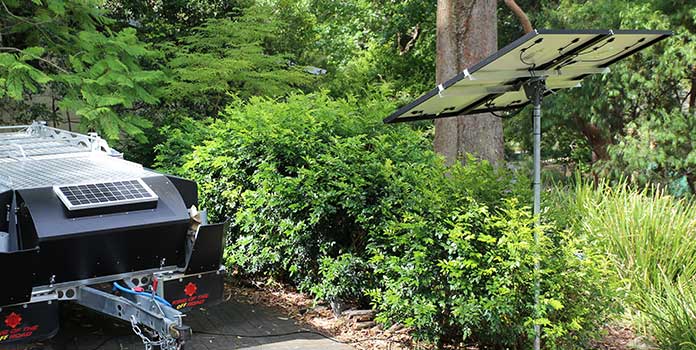

This small mounted solar panel charges the camper when not in use.
The most basic solar kits include the panels, wiring, and charge controller or inverter (depending on whether its off-grid or a grid-tied kit). However, the specific equipment that is included will vary from kit to kit. Some kits are much more robust than others and come with batteries, fuses, additional wiring, etc.
Before buying any kit, read the description and see what components you’ll need to purchase separately. The better kits include installation guides that tell you exactly what you need, like fuses, how many, and what size to purchase.
Regardless of what’s included in the kit, at a minimum, off-grid solar installations need:
- Solar panels to convert sunlight into DC electricity.
- Battery to store the electricity for later use when the sun goes down.
- Charge controller to protect the battery from over-charging and sustaining damage.
- Wiring to connect the three items above.
- Mounting hardware to secure the solar panels. They can be simple Z-brackets that bolt to the solar panel (typically used by RVs and similar) or more complex aluminum railing and bolted L-feet for cabins and homes.
- Fuses between the solar panels and charge controller, and the charge controller and battery.
- (Optional) Inverter to convert the DC electricity in the battery to AC electricity to power AC appliances.
- (Optional) Fuse between the battery and inverter.
Let’s go a bit deeper into some of the primary components above that may or may not be included when you buy a solar panel kit.
Solar Panels
All the kits above include either polycrystalline or monocrystalline solar panels. Monocrystalline solar panels are generally more efficient, and you’ll probably get a little more power out of mono panels, but with the efficiency of poly panels constantly getting better, the practical differences at this point aren’t huge.
Of much greater concern is the location of the solar panels. The placement of your solar panels greatly affect how much power you get out of them. If you’ve got an RV or boat, you’ll likely be very limited to where you can install you panels – probably an open space on a flat roof. If you’re in this situation, the best thing you can do is install the panels and try to avoid obstructions like large trees or buildings that will shade your panels when you park.
If you’re installing on your home or in the backyard, you’ve got a few more options available. In the US, solar panels should face directly south, towards the sun, for the best energy production. And while most homeowners simply install their panels flush to their roof to create a better aesthetic, if you’re looking for max energy production, you can instead choose a mounting system that allows the solar panels to sit at the perfect angle, which is typically 90 degrees from when the sun is highest in the sky.
If you really want to eke out as much as possible from your panels, there’s all manner of mounting hardware to help out. Hardware with arms to angle the panels just right, adjustable racks to move the panels each season, and of course mounting hardware for shingles, metal, shake, and any other roofing type you can think of.
Charge Controllers (Off-Grid Systems)
Like we mentioned, off-grid kits come with charge controllers. This is a cornerstone component of any off-grid solar system, as they keep the power coming out of the panels regulated, ensuring that your batteries aren’t damaged.
Some charge controllers also come with temperature sensors to monitor the battery’s temp. The controller can then adjust the amount of electricity coming from the panels depending on how hot or cold it is. This is an important component if your batteries will suffer through large changes in temperature throughout the year.
If you want to install lithium-ion batteries for your solar installation, you’ll need to choose your charge controller carefully, as some aren’t compatible with Li-ion. Speaking very generally, PWM (Pulse Width Modification) controllers can’t handle Li-ion batteries, but MPPT (Maximum Power Point Tracking) controllers can. However, this isn’t always the case. Some nicer PWM controllers can safely charge Li-ion batteries, so read up on the product or ask the manufacturer before buying.
Inverters (Grid-Connected Systems)
Grid-tied kits usually include inverters to convert the DC electricity provided by your solar panels to AC electricity that can be used in your home. Without an inverter, your grid-tied solar installation would be useless.
The grid-tied kits above come with microinverters that are installed underneath each panel and optimize each panel individually for max production. Microinverters are now the dominant form of inverter in the residential market, thanks to their greater energy production and better system monitoring capabilities when compared to conventional string inverters.
The most complete off-grid kits also come with inverters. Whether or not you need one depends on what you’re doing – many appliances built for use in RV’s and motor homes are meant for use with DC electricity and powering things like lights can often be done with DC. If you use any AC appliances (ie gadgets that plug into your home outlets), you’ll need an inverter.
Your inverter’s size depends on what you intend to do with it. Inverters for grid-tied kits are sized to convert all the electricity produced into AC – every last drop. Inverters for off-grid systems though are usually sized by need. Small to medium off-grid kits that do come with inverters usually have at least 1500 – 2000 watts. Large systems can go up to 5,000 or 6,000 watts.
For off-grid installations, be sure to find out whether the inverter produces a modified sine wave or a pure sine wave. Modified sine wave inverters are cheaper, but some delicate electronics like older computers, CPAP machines, and battery chargers don’t like them and need pure sine waves. Grid-tied inverters are always pure-sine, but for off-grid systems you get to choose.
Wiring and Fuses
All solar kits come with at least some wiring, but few kits include all the wiring you need.
All solar panel kits include the wiring to connect the solar panels to the charge controller or inverter. Only a handful though include wiring to connect the charge controller to the battery and the battery to the inverter. For each kit above, we’ve noted what wiring comes with each kit.
You’ll also need fuses to protect the wiring, but you’ll likely need to purchase those separately as kits typically don’t include these either. The better ones include information on finding the right size wiring and fuses, but others don’t provide that info, so you’ll have to do some research yourself.
In a nutshell, if it’s a wire, it needs a fuse or breaker! You’ll need them between the solar panels and controller, between the controller and the battery, and between the battery and inverter. Don’t worry too much though. There’s lots of info available online on this very subject, including handy calculators to make the process easy.
Mounting Hardware
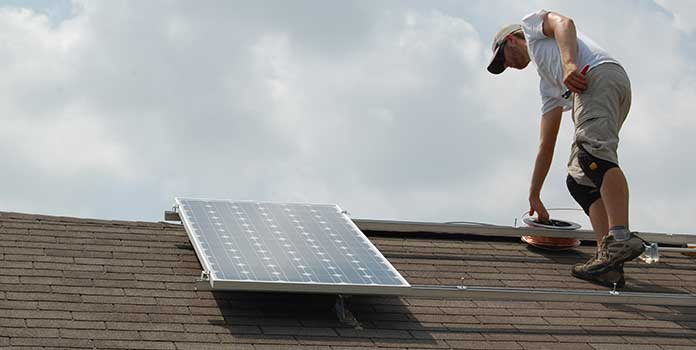

A typical grid-tied solar installation, with panels bolted to aluminum railings that are bolted to the roof with L-feet.
Most small solar kits designed for RVs or boats come with mounting hardware that allow you to mount the solar panels on a roof or other flat surface. These are typically simple brackets and bolts designed to securely fasten each solar panel individually to a roof.
If you’re looking at larger installations for a cabins or home, you’ll probably want to purchase a more substantial mounting system, like the one in the picture above. Many solar panel companies also sell mounting kits to make the process easier, as it’s a bit more complicated than just securing a couple bolts like on an RV.
Study the picture above and you can see how it works. At each corner, the solar panels are bolted to two aluminum rails. The aluminum rails are then connected to brackets called L-feet. The L-feet are then bolted through your shingles (or around your roof tiles) to your ceiling rafters (yes, the ones you can see in your attic). Metal flashing around the bolt makes everything waterproof.
As you can see, it’s not rocket science, but you need to know what you’re doing to avoid structural or water damage. A kit helps by taking a lot of the guess work out of the equation.
Not Typically Included: Batteries
Most kits don’t come with batteries, but these are a vital part of any off-grid system. The size of the battery will dictate how much power you can store, and how much juice you’ve got available at any one time.
It’s important to note you should only use deep cycle batteries – those designed to withstand continuous, heavy use – for your solar installation. While car batteries use the same technology (lead-acid) as many solar batteries, they’re designed to give a big burst of power for a very short time span so you can start your car. If you use car batteries for your solar project, you’ll burn them out very quickly.
Deep-cycle batteries come in many different technologies: flooded lead-acid, AGM lead-acid, gel lead-acid, lithium-ion. Each has its own merits and drawbacks, mostly around lifespan, cost, and ease of use.
You should also note that, while some battery types are more expensive than others, batteries are pricey no matter what technology you choose – expect a fair amount of your budget to go into energy storage.
Why Use a Solar Kit?
You might be wondering why you should even think about using a solar kit. If you’re installing solar on your RV or camper, that’s a pretty easy question to answer. It’s a weekend project and quite fun!
However, if you’re thinking about installing a large solar kit on a home or cabin, that’s a totally different ball game.
Hiring a solar company to install a solar installation for you is a pretty expensive endeavor. In the residential solar market, ‘soft costs’ like labor, marketing, and profit (basically everything but the equipment and hardware costs) account for a shockingly-high 68% of an installation’s total cost. That means just 32% of the entire cost to put solar on your home goes to the actual hardware!
Needless to say, cutting out all those soft costs will do wonders for your bottom line. If you’ve got the experience, know-how, and drive, you can save potentially thousands of dollars by installing your own solar kit. You might not see a 70% savings, as solar companies have access to wholesale equipment prices and you’ll likely pay marked-up dealer prices. Still, you’re almost guaranteed to see a lower overall cost.
Beyond saving some cash, installing your own solar kit allows you to understand your solar installation inside and out. That might not sound important now, but if you’re a DIYer, that’s a huge help when something stops working down the line. You’ll be able to quickly figure out what’s wrong, as you understand each component of the system and exactly what it is.
Installing a solar kit also gives you the satisfaction of knowing that you built your own clean energy system!
Should You Install a Solar Kit Yourself?
Just because you can install solar yourself, doesn’t mean you should install solar yourself. Again, small off-grid kits are relatively cheap and easy to install. Take a weekend and add one to your RV or small cabin. If something stops working, at least you haven’t sunk excessive time and money on the project (hopefully).
Larger installations though require much more knowledge and skills. First, you need to understand how to install your system’s electrical components safely. Working out wire sizes, conduit sizes, and fuse and breaker sizes correctly is of the upmost importance and doing it wrongly can be potentially deadly.
On top of that, you’ll have to install the solar panels safely. Panels are basically just glass sails and a strong wind can pull them from the roof or push them against the roof and cause damage. You need to know the panels and equipment are bolted down safely and are waterproof.
Again, it’s not rocket science but you need to know that it’s done correctly. Hiring a professional can save huge headaches and cost down the line. Large kits are still doable, but there’s a lot more risk if something goes wrong.
If you are looking for a large system to power your home then it is smarter to find the best solar panels and then hire a professional to install them.
Off-Grid vs Grid-Connected Kits – Know the Difference
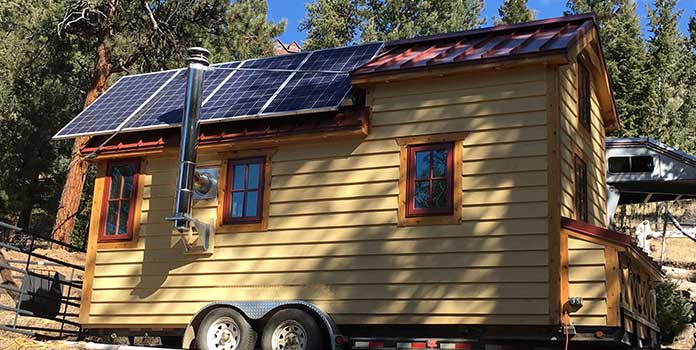

Looking at our list of best solar kits, you’ll see that some are designed for off-grid use, while others are for grid-connected homes.
Off-grid systems – those installations not connected to any utility electricity – typically require a battery bank, inverter, and charge controller. The solar panels produce electricity that either goes to your lights and appliances or to the battery for use later on.
Solar kits for off-grid systems run the gamut from small 100 watt system for RVs and campervans to large 3,000 watt systems for cabins and such. Kits typically include the solar panels, wiring, and charge controller.
Tip: If the kit comes with a charge controller, it’s usually a dead giveaway that it’s designed for off-grid systems.
Solar kits for grid-connected homes are typically only found in the largest sizes – 1,000 watts up to 10,000 watts. Grid-connected homes use much more power than off-grid systems, so it really doesn’t make sense to make small kits for this application.
Solar kits for grid-tied homes usually include the solar panels, wiring, and inverter – no charge controller or battery. Why is that? Because in grid-tied installations, the solar electricity powers the home and all its gadgets, or goes to the grid (via a net metering agreement). There’s no storage system, therefore no batteries or charge controller. Batteries for grid-tied systems are becoming more common, especially in areas with high utility rates like Hawaii and California, but they’re still a small percentage of total solar installations.
An important note: Since residential solar installations are installed on your home and connected to the utility, you’ll need both the city’s and the utility’s approval before installing your system.
Few homeowners actually attempt to install their own grid-connected solar kit, but it is possible depending on your area’s regulations. Some utilities and county building departments – typically in rural areas – do allow homeowners to install a grid-connected solar installation on their own home, but most do not.
You’ll need to reach out to both your utility as well as your local building department for the rules around installing your own solar installation and connecting it to the grid.
Off-grid solar installations, since they aren’t connected to the larger grid, have much fewer regulations around them.
While both off-grid and grid-tied solar kits share some of the same materials – panels and wiring for example – that’s where their similarities end, as they have very different requirements for energy storage, inverter, and charge controllers.
Are Grid-Connected Solar Kits Legal?
Basically, it depends on your area. For the safety of everyone connected to the electricity grid, there are quite a few requirements for grid-connected solar to be legal.
To ensure the safety of the solar installation, most utilities and local authorities (typically your city or county building department) adhere to the National Electric Code and the International Building Code (NEC and IBC, respectively), which set up standards for all manner of details: the depth of the lag screws into your roof rafters, how much space is necessary between your solar panels and the edge of your roof, how many wires and what size can be placed inside electrical conduit running across your roof – that sort of thing.
Your first step to install a grid-connected solar kit is to ensure that you have a safe, legal solar installation that fulfills all these safety requirements.
Your second step is to contact your building department and utility company to see if they allow non-professional homeowners to install their own solar installations. This might be an outright “no”, an outright “yes”, or even a “yes, but you need an electrician to sign off on the designs and installation”. The only way to know is to get on the phone or stop by their offices.
Solar kits for off-grid systems are a completely different ballgame. You obviously don’t need to contact your utility (since you aren’t connected to one), but your county likely has rules around building codes and being unconnected to the grid, so give them a call before you purchase any big system.
And if you’re buying your solar kit for your RV or camper, you’re generally okay to move forward, though there are still laws around RV electrical systems you’ll likely want to be aware of.
With so many different sizes and included equipment, the best solar panel kit is really dependent on your own needs. Before buying anything, you’ll want to consider what you plan on using it for and how much solar power you will need to generate. Once you’ve considered these questions, hopefully one of the kits above will suit your needs!
Here’s out list of best solar kits for 2019 one last time:
- Best All-In-One Kit: WindyNation 400 Watt Solar Panel Kit
- Best Basic Kit: Renogy 400 Watt 12 Volt Monocrystalline Solar Starter Kit
- Best For Adding Panels: Grape Solar 400-Watt Off-Grid Solar Panel Kit
- Most Efficient Kit: HQST 400 Watt 12 Volt Monocrystalline Solar Panel Kit
- BestOverall Kit: Renogy 1800 Watt Kit
- Easiest-to-Install Kit: PluggedSolar 1.5kW Grid-Tie Kit
- Best Deal: PluggedSolar 5kW Grid-Tie Kit
- Most Efficient Kit: Grape Solar 5300 Watt with Enphase Microinverters
If you have any additional questions, feel free to ask away in the comments! Want to just hire someone to install your installation? Start by reaching out to a few installers and seeing what’s available.

